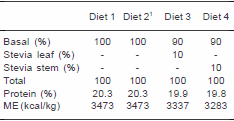Introduction
Stevia (Stevia rebaudiana, Bertoni) is a perennial shrub that is indigenous to Paraguay and Brazil. The leaf, and its extracts have been used as a natural sweetener.
Often referred to as the sweet herb of Paraguay (Geuns, 2004), stevia is today grown commercially for sweeteners extraction.
The sweetening property is associated with their contents of several glycosides, stevioside, steviobioside, rebaudiosides A to F, dulcoside A and steviol (Gardana et al., 2003; Geuns, 2004). These glycosides and their derivatives are known to account for 4-20% of the dry weight of stevia leaves (Oliveira-Filho et al., 1989; Geuns et al., 2003). There is a preferential accumulation of different glycosides in different parts of the plant (Alves and Ruddat, 1979; Richman et al., 1999) more apparent in mature than young stevia tissues for sweetening glycosides (Geuns, 2004).
Stevia and its extract have been studied widely from the sweetener and medicinal points of view (Oviedo et al., 1970; Takaki et al., 1985; Melis, 1999). A search through literature shows no information on the non-sweetening components which make up 80- 90% dry weight of this plant. This study provides the biochemical/nutritional profile of the leaves and stems and the potential utilization of the nutrients by broiler chickens as an animal model.
Materials and methods
Dried and ground stevia leaves and stem were obtained from Stevita Company in Brazil. Quadruplicate samples of the ground leaves and stems were analyzed for protein, fat, crude fibre, ash, minerals, fatty acids profile, stevioside and rebaudioside A. The apparent metabolisable energy (AME), apparent nitrogen-corrected metabolisable energy (AMEn) and true metabolisable energy (TME) of the leaves and stems were determined using 4 weeks old male Cobb broilers (average weight 1.4 kg). Birds were raised on a standard wheat-maize-soya based starter (day 1-14) and grower (day 14- 28) diets. To determine the ME values, the ground leaves and stems were incorporated into basal diet at 10% inclusion level (w/w). Twelve birds were individually caged in digestibility cages and fed 4 experimental diets shown in table I. The birds had a 3 day adaptation followed by a 24 h excreta collection period. Birds on treatments 1 and 2 were fed the basal grower diet while those on treatments 3 and 4 were fed diets in which stevia leaves and stem respectively replaced 10% of the basal diet. Thus, there were 4 treatments, each with 3 replicates of individually caged birds. Birds were supplied water ad libitum. At 24 h before the beginning of excreta collection, feed was withdrawn from birds on treatment 2 thereby clearing the gut of digesta. Weighed quantities of feed were supplied to birds on treatments 1, 3, and 4 and excreta collected over a 24 h period. Excreta voided by birds on treatment 2 during the collection period were also collected to estimate metabolic excreta weight. The excreta samples were dried, weighed and ground. The experiment was repeated twice and data were pooled from both experiments for analysis.
The gross energy in feed and excreta samples was determined using a ballistic bomb calorimeter. Apparent ME and true ME of stevia leaves and stems were calculated. The feed and excreta samples were also analyzed for nitrogen to calculate N retention. Data were analysed by t-test to compare leaves and stems (statistical significance was set at <5%).
Table I. Experimental grower diets used for digestibility study. (Dietas experimentales usadas para el estudio de digestibilidad).
1 Feed withdrawn 24 h prior to a 24 h excreta collection period.
Results
Table II summarizes the analytical composition of stevia. The protein and fat contents of the leaves was more than twice the concentration in the stem. The same trend was observed for ash content. The stem consists of 45% crude fiber as opposed to less than 7% in the leaves. The stevioside content of stevia leaves was 6.5% compared to 0.69% in the stem. Rebaudioside A content of the leaves was 2.3% as opposed to 0.3% in the stem.
Table II. Proximate, stevioside, rebaudioside A, (n=4, % DM) gross and metabolisable energy content (n=6, kcal/kg) of stevia leaf and stem. (Composición nutritiva, esteviósido, rebaudiósido A, energía bruta y metabolizable en hojas y tallos de Stevia).
absignificant difference, leaf vs. stem, for each analysis (p <0.05). SFA= Saturated fatty acids; USFA= Unsaturated fatty acids.>
There were variations in the fatty acid profiles of stevia. Stevia leaves fat extract contained more saturated fatty acid than stems. The reverse was true for the total unsaturated fatty acid. Linoleic acid (C18:3) was the dominant fatty acid in stevia leaf (36%). In contrast, oleic acid (C18:2) was the dominant fatty acid in stem.
Ca and Mg levels were 20-fold higher in leaves than stems. The Fe content of leaves was 30-fold higher than in the stem. P, Zn and Cu were higher to lesser extent. The contrast was true for Na and K. There were only traces of Coin both leaves and stems.
Although both the leaves and stem had comparable gross energy values, apparent, nitrogen-corrected, and true metabolisable energy values were higher in leaves than stems. The calculated retention of protein from leaves was 63% and 65.7% from stems.
Discussion
The stevioside and rebaudioside A contents of leaves and stems are within those reported in literature (Mizukami et al., 1982; Geuns, 2004; Hashimoto and Moriyasu, 1978). There was evidence from this study, of a preferential deposition of stevioside and rebaudioside A in the leaves.
The non-sweetener nutritional profile of stevia leaves and stem was close to that of some flowering plants. The protein content of the leaves (16%) was comparable to that reported for cassava leaf meal (Aduku, 1993) and alfalfa (NRC, 1994). The fat content of stevia leaves was also low and comparable with those of non-oil bearing plants. The fatty acid profile of stevia oil showed high degree of unsaturation and a clear difference in the fatty acid profile between the leaves and the stem. The high concentrations of polyunsaturated fatty acids in stevia oil implied that stevia plant might be a fodder source of nutritionally desirable fatty acids.
The high crude fiber and low metabolisable energy content of stevia stem were suggestive of low nutritional value for monogastric animals including man. However, there might be a potential use for this roughage as a sweet energy diluent for monogastric animals and as a source of energy for ruminant animals that are equipped to digest high fiber diets. Stevia leaves may be classified as a high-energy fodder. The test with chickens suggests that it was non-caloric as evidenced by the AME values. The protein content of both the leaves and stem seemed to be moderately digestible and retained in the broilers. Stevia leaves were richer in minerals than the stem with the exception of sodium and potassium that were more abundant in the stem. The high iron content of the leaves might have potential benefits in anemic conditions.
In conclusion, the nutritional profile of stevia plant suggests that it contains high levels of protein and gross energy that may be suitable for ruminant animals rather than for monogastric animals such as chickens. It could, however, be used as an energy diluent in monogastric diets due to its low ME and non-caloric nature.
This article was originally published in Archivos de Zootecnia. 60 (229): 133-136. 2011.
References
Aduku, A.O. 1993. Tropical feedstuff analysis table. Asekome & Co Publishers. Zaria. Nigeria.
Alves, L.M. and Ruddat, M. 1979. The presence of gibberelling A20 in Stevia rebaudiana and its significance for the biological activity of steviol. Plant Cell Physiol., 20: 123-130.
Gardana, C., Simonetti, P., Canzi, E., Zanchi, R. and Pietta, P.G. 2003. Metabolism of stevioside and rebaudioside A from Stevia rebaudiana extracts by human microflora. J. Agric. Food Chem., 51: 6618-6622.
Geuns, J.M.C. 2004. Review: The safety of stevioside used as a sweetener. Proc. 1st Symposium: The Safety of Stevioside. KULeuven, April 16th 2004. Euprint ed., Parkbosstraat 3. 3001 Heverlee. Belgium. pp. 85-127.
Geuns, J.M.C, Augustijns, P., Mols, R., Buyse, J.G. and Driessen, B. 2003. Metabolism of stevioside in pigs and intestinal absorption characteristics of stevioside, rebaudioside A and steviol. Food Chem. Toxicol., 41: 1599-1607.
Hashimoto, Y. and Moriyasu, M. 1978. Determination of sweet components in Stevia rebaudiana by high-performance liquid chromatography ultraviolet detection. Shoyakugaku Zasshi, 32: 209-211.
Melis, M.S. 1999. Effect of crude extract of Stevia rebaudiana on renal water and electrolytes excretion. Phytomedicine, 6: 247-250
Mizukami, H., Shiba, K. and Ohashi, H. 1982. Enzymatic determination of stevioside in Stevia rebaudiana. Phytochemistry, 21: 1927-1930.
NRC. 1994. Nutrient Requirements of Poultry. 9th Revised ed. National Academy of Science. Washington, DC.
Oliveira-Filho, R.M., Uehara, O.A., Minnet, C.A.S.A. and Valle, L.S.B. 1989. Chronic administration of aqueous extract of Stevia rebaudiana (Bert.) Bertoni in rats: Endocrine effects. Gen. Pharmacol., 20: 187-191.
Oviedo, C.A., Fronciani, G., Moreno, R. and Maas, L.C. 1970. Hypoglycemic action of Stevia rebaudiana. Excerpta Medica, 209: 92.
Richman, A.S., Gijzen, M., Starratt, A.N., Yang, Z. and Brandle, J.E. 1999. Diterpene synthesis in Stevia rebaudiana: recruitment and up-regulation of key enzymes from the gibberellin biosynthetic pathway. Plant J., 19: 411-421.
Takaki, M., De Campos Takaki, G.M., De Santana Diu, M.B., De Andrade, M.S.S. and Da Silva, E.C. 1985. Antimicrobial activity in leaves extract of Stevia rebaudiana Bert. Rev; Inst. Antibiot. Univ. Pernambuco. Recife 12, 33-39.











.jpg&w=3840&q=75)